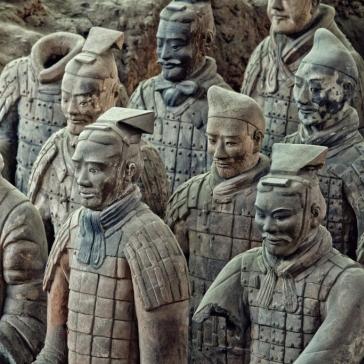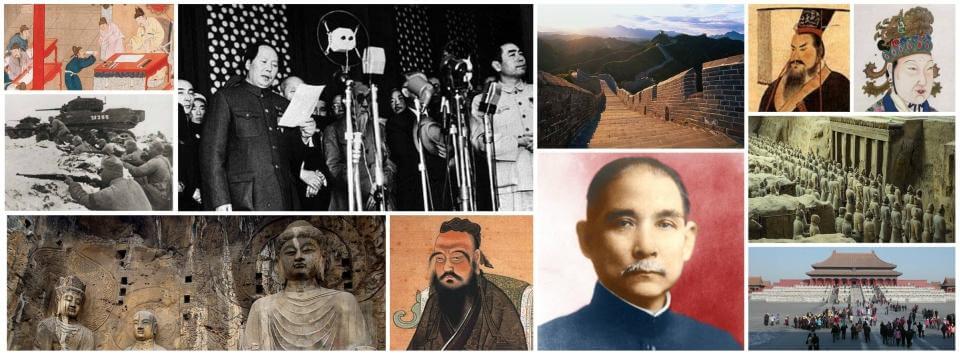
Qin Dynasty (221 – 206 BC)
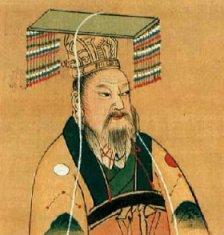 China's first emperor Qin Shi HuangAfter ending the Eastern Zhou dynasty in 256 BC, the Qin went on to defeat the remaining six larger states one after the other under the leadership of their ruler Qin Shi Huang (then still named King Zheng of Qin). Their last opposition, the state of Qi, fell in 221 BC and the unification of China was complete. Whereas until then the rulers were entitled as kings, Qin Shi Huang (259 - 210 BC) became the first Chinese emperor by claiming the title huangdi (title of the mythological rulers of ancient times) for himself, thereby claiming total control and ownership over all of China.
China's first emperor Qin Shi HuangAfter ending the Eastern Zhou dynasty in 256 BC, the Qin went on to defeat the remaining six larger states one after the other under the leadership of their ruler Qin Shi Huang (then still named King Zheng of Qin). Their last opposition, the state of Qi, fell in 221 BC and the unification of China was complete. Whereas until then the rulers were entitled as kings, Qin Shi Huang (259 - 210 BC) became the first Chinese emperor by claiming the title huangdi (title of the mythological rulers of ancient times) for himself, thereby claiming total control and ownership over all of China.
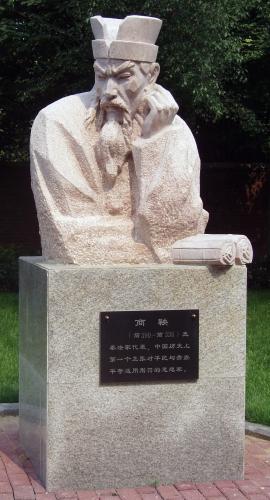 Statue of the Qin state's chief minister Shang YangBesides Qin Shi Huang's leadership, this unification of China was realized through the Qin military's use of modern weaponry, transportation and warfare tactics. Ideologically, the Qin state's doctrine of legalism contributed to its success during the Warring States period. It had begun to develop during the Warring States period and is based upon the concept of reward and punishment.
Statue of the Qin state's chief minister Shang YangBesides Qin Shi Huang's leadership, this unification of China was realized through the Qin military's use of modern weaponry, transportation and warfare tactics. Ideologically, the Qin state's doctrine of legalism contributed to its success during the Warring States period. It had begun to develop during the Warring States period and is based upon the concept of reward and punishment.
According to this doctrine, the state belongs to the ruler, who will wisely use reward and punishment to motivate his subjects to do what he wants them to do. Shang Yang - the Qin state's chief minister during the mid-4th century BC - began to promulgate a series of rules and laws governing most aspects of society. The penalty for breaking those rules and laws, even if the criminal offences were only minor in nature, was often severe (for example the amputation of body parts, death, banishment etc.).
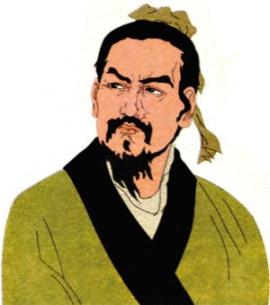 picture of the thinker Han FeiThese laws were not just simply passed by the rulers, but their existence and promulgations were effectively disseminated all around the Qin state to make sure that everyone knew about them. It was thought, that the existence of such tough laws would contribute to a well-ordered society, simply because everyone knew what the strict punishment for failing to obey them was.
picture of the thinker Han FeiThese laws were not just simply passed by the rulers, but their existence and promulgations were effectively disseminated all around the Qin state to make sure that everyone knew about them. It was thought, that the existence of such tough laws would contribute to a well-ordered society, simply because everyone knew what the strict punishment for failing to obey them was.
For this system to work effectively, it was absolutely necessary that the laws would be applied equally to everyone in society, irrespective of their status or rank and the Qin were fair in that regard at first. Whether nobleman or peasant, the punishment for similar transgressions was meted out fairly and equally.
In the 3rd century BC, a thinker of the shi elite named Han Fei, who was recruited by the leaders of the Qin state for his ideas, developed these tribulations further and gave them a philosophical perspective. According to his philosophy, all people are selfish and greedy by nature and will always try to maximise their personal gain while minimizing their personal loss.
Qin Shi Huang's proclaimed Qin dynasty only lasted from 221 until 207/206 BC. During that time, the Qin managed to usurp and control the largest area (much larger then the Zhou state at its peak time) that was ever controlled by a Chinese state until then. They undertook many reforms in their land and created a single unified administration. That facilitated the standardization of many systems, that were changed or developed independently during the preceding period of fragmentation.
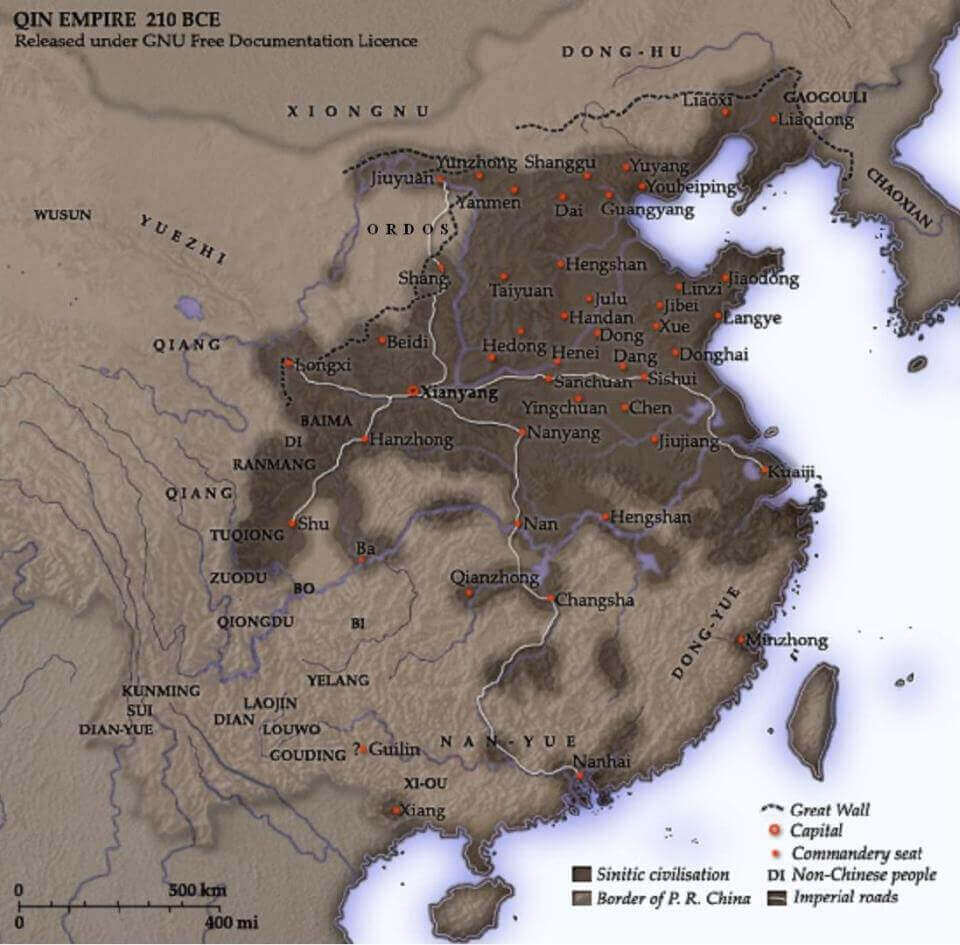 map showing the extension of the Qin Empire in the year 210 BC
map showing the extension of the Qin Empire in the year 210 BC
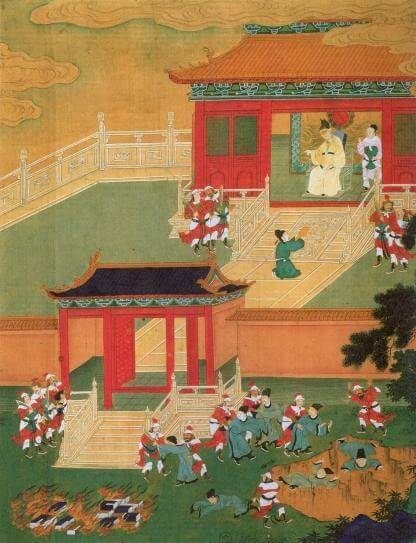 painting of the Burning of Books and the Burying of ScholarsFor example, the Qin decreed that all carts had to have the same axle width
(the axle width that was the standard in the Qin state before the unification), which facilitated the development of a unified transportation system within China. Coinage was unified as well. The Qin coins
that were round with a square hole in the middle (for easy carrying on a string) became the official currency all over China. Perhaps most importantly, the Chinese written characters that the Qin used became the new national standard. Furthermore, the Qin created a standardized ideology, casting aside Confucianism, Daoism, Moism and others in favour of their own ideology - legalism.
painting of the Burning of Books and the Burying of ScholarsFor example, the Qin decreed that all carts had to have the same axle width
(the axle width that was the standard in the Qin state before the unification), which facilitated the development of a unified transportation system within China. Coinage was unified as well. The Qin coins
that were round with a square hole in the middle (for easy carrying on a string) became the official currency all over China. Perhaps most importantly, the Chinese written characters that the Qin used became the new national standard. Furthermore, the Qin created a standardized ideology, casting aside Confucianism, Daoism, Moism and others in favour of their own ideology - legalism.
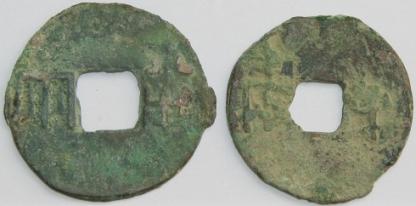 Qin dynasty coinsIn the year 214 BC, that led to an event called the "Burning of Books and the Burying of Scholars" when the population had to hand over all books that were not about legalism or practical or mathematical matters. All other books were banned from then on and were (often ceremoniously) burned, sometimes along with their owners who had been reluctant to hand them over (few books from before the later fall of the Qin dynasty remain today). Books were copied by hand back then (printing was invented around AD 600) and much of the knowledge was transmitted orally from teacher to student. To ensure the complete eradication of all unwelcome ideas, Emperor Qin Shi Huang ordered that all scholars of these ideas (and who therefore knew them by heart) were buried alive, preventing the further oral dissemination of these ideas.
Qin dynasty coinsIn the year 214 BC, that led to an event called the "Burning of Books and the Burying of Scholars" when the population had to hand over all books that were not about legalism or practical or mathematical matters. All other books were banned from then on and were (often ceremoniously) burned, sometimes along with their owners who had been reluctant to hand them over (few books from before the later fall of the Qin dynasty remain today). Books were copied by hand back then (printing was invented around AD 600) and much of the knowledge was transmitted orally from teacher to student. To ensure the complete eradication of all unwelcome ideas, Emperor Qin Shi Huang ordered that all scholars of these ideas (and who therefore knew them by heart) were buried alive, preventing the further oral dissemination of these ideas.
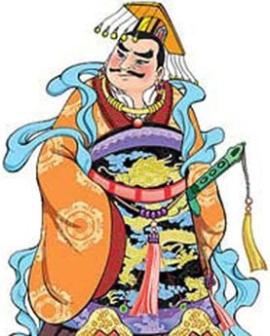 Qin Er Shi, the 2nd emperor of the Qin DynastyAfter the fall of the Qin, there was a flurry of activity among the remaining scholars to recreate these works from memory. There are now many alternate versions of certain books that were written down during this period, due to the fact that the scholarly scribes remembered things differently.
Qin Er Shi, the 2nd emperor of the Qin DynastyAfter the fall of the Qin, there was a flurry of activity among the remaining scholars to recreate these works from memory. There are now many alternate versions of certain books that were written down during this period, due to the fact that the scholarly scribes remembered things differently.
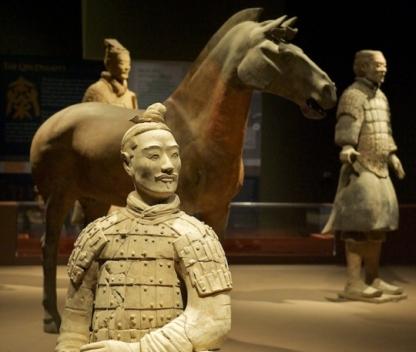 exposition of terracotta warriors and horsesEven though the Qin philosophy of legalism was perfectly suited to a time of conflict and uncertainty during the Warring States period, it was less suited to the times of peace that followed the unification of China. The lack of a need for moral restraint among the rulers (since legalism gave the Qin rulers the mandate of absolute power that they used ruthlessly to further their self-interest) led to the ruthless exploitation of the people and abuses of power. After Emperor Qin Shi Huang suddenly and unexpectedly died under mysterious circumstances in 210 BC, it didn't take long for the first uprising against the Qin rulers to materialize.
exposition of terracotta warriors and horsesEven though the Qin philosophy of legalism was perfectly suited to a time of conflict and uncertainty during the Warring States period, it was less suited to the times of peace that followed the unification of China. The lack of a need for moral restraint among the rulers (since legalism gave the Qin rulers the mandate of absolute power that they used ruthlessly to further their self-interest) led to the ruthless exploitation of the people and abuses of power. After Emperor Qin Shi Huang suddenly and unexpectedly died under mysterious circumstances in 210 BC, it didn't take long for the first uprising against the Qin rulers to materialize.
The Terracotta Warriors and Horses that were discovered accidentally by farmers digging for water near Qin Shi Huang's yet-unopened mausoleum are now one of the major tourist attractions in China and a part of the Emperor Qin Shi Huang's Mausoleum Site Park.
After Emperor Qin Shi Huang's death, his inept son Huhai followed him on the throne as the 2nd emperor. Huhai ruled under the name Qin Er Shi but his rule didn't last very long. During his short reign, a number of uprisings erupted among the people against the harsh rulership of the Qin. One of these revolts by loyalists of the former Chu state brought the Qin dynasty to an end in the year 206 BC. Emperor Qin Er Shi didn't even see the end of the dynasty that his father had built. He had already been forced to commit suicide the previous year (207 BC) by one of his officials. So it was the relatively obscure Ziying who came to rule the rapidly disintegrating Qin state for its last days of existence.
Terracotta Warriors
The Terracotta Warriors were the funerary army of Emperor Qin Shi Huang, the founding emperor of the Qin dynasty. Emperor Qinshihuang's Mausoleum Site Museum which is located 40km east of Xi'an is one of the most visited tourist sights in China. The UNESCO world heritage site consists of the Museum of the Terracotta Warriors and Horses & Qin Shi Huang's Mausoleum Site Park.
Click here to learn more!Opening Hours
March 16 to November 15: 8.30am - 6pm
November 16 to March 15: 8.30am - 5.30pm
Tickets available until 1 hour before closing time
Entrance Ticket Prices
120 yuan
Visitors must show passports or ID's to buy tickets
Chinese History Digest's summary of China's history continues in the next section with how succeeding power struggles culminated in the establishment of the Han dynasty.
